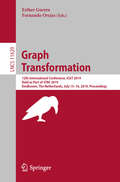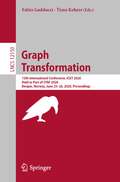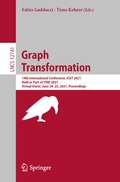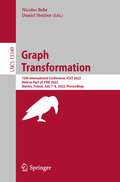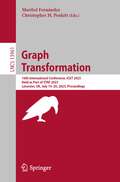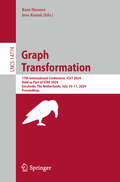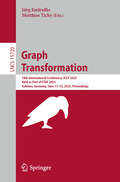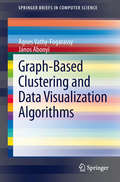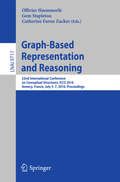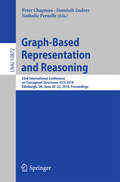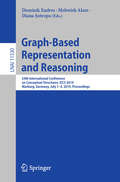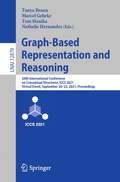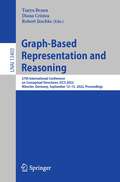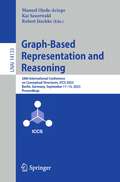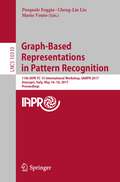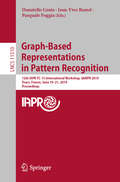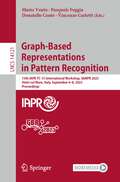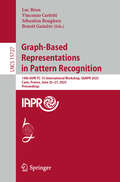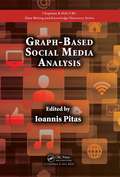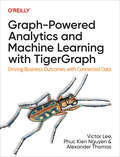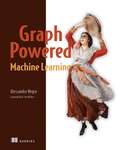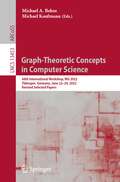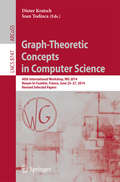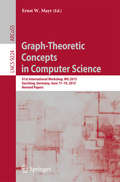- Table View
- List View
Graph Transformation: 12th International Conference, ICGT 2019, Held as Part of STAF 2019, Eindhoven, The Netherlands, July 15–16, 2019, Proceedings (Lecture Notes in Computer Science #11629)
by Esther Guerra Fernando OrejasThis book constitutes the refereed proceedings of the 12th International Conference on Graph Transformation, ICGT 2019, held as part of STAF 2019, in Eindhoven, The Netherlands, in July2019. The 12 research papers and 1 tool paper presented in this book were carefully reviewed and selected from 22 submissions. The papers deal with the following topics: Theory, Analysis and Verification, Tools and Applications, and Transformation Rules Construction and Matching.
Graph Transformation: 13th International Conference, ICGT 2020, Held as Part of STAF 2020, Bergen, Norway, June 25–26, 2020, Proceedings (Lecture Notes in Computer Science #12150)
by Fabio Gadducci Timo KehrerThis book constitutes the refereed proceedings of the 13th International Conference on Graph Transformation, ICGT 2020, in Bergen, Norway, in June 2020.*The 16 research papers and 4 tool paper presented in this book were carefully reviewed and selected from 40 submissions. One invited paper is also included. The papers deal with the following topics: theoretical advances; application domains; and tool presentations.*The conference was held virtually due to the COVID-19 pandemic.
Graph Transformation: 14th International Conference, ICGT 2021, Held as Part of STAF 2021, Virtual Event, June 24–25, 2021, Proceedings (Lecture Notes in Computer Science #12741)
by Fabio Gadducci Timo KehrerThis book constitutes the refereed proceedings of the 14th International Conference on Graph Transformation, ICGT 2021, which took place virtually during June 24-25, 2021.The 14 full papers and 2 tool papers presented in this book were carefully reviewed and selected from 26 submissions. They deal with the following topics: theoretical advances; application domains; and tool presentations.
Graph Transformation: 15th International Conference, ICGT 2022, Held as Part of STAF 2022, Nantes, France, July 7–8, 2022, Proceedings (Lecture Notes in Computer Science #13349)
by Nicolas Behr Daniel StrüberThis book constitutes the refereed proceedings of the 15th International Conference on Graph Transformation, ICGT 2022, which took place Nantes, France in July 2022.The 10 full papers and 1 tool paper presented in this book were carefully reviewed and selected from 19 submissions. The conference focuses on describing new unpublished contributions in the theory and applications of graph transformation as well as tool presentation papers that demonstrate main new features and functionalities of graph-based tools.
Graph Transformation: 16th International Conference, ICGT 2023, Held as Part of STAF 2023, Leicester, UK, July 19–20, 2023, Proceedings (Lecture Notes in Computer Science #13961)
by Maribel Fernández Christopher M. PoskittThis book constitutes the refereed proceedings of the 16th International Conference on Graph Transformation, ICGT 2023, held as Part of STAF 2023 in Leicester, UK, in July 2023. The 14 full papers and 2 short papers presented in this book were carefully reviewed and selected from 29 submissions. The conference focuses on describing new unpublished contributions in the theory and applications of graph transformation as well as tool presentation papers that demonstrate main new features and functionalities of graph-based tools.
Graph Transformation: 17th International Conference, ICGT 2024, Held as Part of STAF 2024, Enschede, The Netherlands, July 10–11, 2024, Proceedings (Lecture Notes in Computer Science #14774)
by Russ Harmer Jens KosiolThis book constitutes the refereed proceedings of the 17th International Conference on Graph Transformation, ICGT 2024, held in Enschede, The Netherlands, during July 10–11, 2024. The 10 full papers and 3 short papers included in this book were carefully reviewed and selected from 21 submissions. They were organized in topical sections as follows: Theoretical Advances; Application Domains; and Tool and Blue Skies Presentations.
Graph Transformation: 18th International Conference, ICGT 2025, Held as Part of STAF 2025, Koblenz, Germany, June 11–12, 2025, Proceedings (Lecture Notes in Computer Science #15720)
by Jörg Endrullis Matthias TichyThis book constitutes the refereed proceedings of the 18th International Conference on Graph Transformation, ICGT 2025, held in Koblenz, Germany, during June 11-12, 2025.The 10 full papers and 1 short paper included in this book were carefully reviewed and selected from 19 submissions. The topics of the accepted papers cover a wide spectrum, ranging from advancements in the classical theory of graph transformation to the integration of artificial intelligence approaches with graph transformations, the fuzzing of graph databases, and applications of graph transformation in areas such as dialogue management systems and threat analysis.
Graph-Based Clustering and Data Visualization Algorithms
by János Abonyi Ágnes Vathy-FogarassyThis work presents a data visualization technique that combines graph-based topology representation and dimensionality reduction methods to visualize the intrinsic data structure in a low-dimensional vector space. The application of graphs in clustering and visualization has several advantages. A graph of important edges (where edges characterize relations and weights represent similarities or distances) provides a compact representation of the entire complex data set. This text describes clustering and visualization methods that are able to utilize information hidden in these graphs, based on the synergistic combination of clustering, graph-theory, neural networks, data visualization, dimensionality reduction, fuzzy methods, and topology learning. The work contains numerous examples to aid in the understanding and implementation of the proposed algorithms, supported by a MATLAB toolbox available at an associated website.
Graph-Based Natural Language Processing and Information Retrieval
by Rada Mihalcea Dragomir RadevGraph theory and the fields of natural language processing and information retrieval are well-studied disciplines. Traditionally, these areas have been perceived as distinct, with different algorithms, different applications and different potential end-users. However, recent research has shown that these disciplines are intimately connected, with a large variety of natural language processing and information retrieval applications finding efficient solutions within graph-theoretical frameworks. This book extensively covers the use of graph-based algorithms for natural language processing and information retrieval. It brings together topics as diverse as lexical semantics, text summarization, text mining, ontology construction, text classification and information retrieval, which are connected by the common underlying theme of the use of graph-theoretical methods for text and information processing tasks. Readers will come away with a firm understanding of the major methods and applications in natural language processing and information retrieval that rely on graph-based representations and algorithms.
Graph-Based Representation and Reasoning
by Gem Stapleton Ollivier Haemmerlé Catherine Faron ZuckerThis book constitutes the proceedings of the 22th International Conference on Conceptual Structures, ICCS 2016, held in Annecy, France, in July 2016. The 14 full papers and 5 short papers presented in this volume were carefully reviewed and selected from 40 submissions. They are organized around the following topical sections: time representation; graphs and networks; formal concept analysis; ontologies and linked data.
Graph-Based Representation and Reasoning: 23rd International Conference on Conceptual Structures, ICCS 2018, Edinburgh, UK, June 20-22, 2018, Proceedings (Lecture Notes in Computer Science #10872)
by Peter Chapman Dominik Endres Nathalie PernelleThis book constitutes the proceedings of the 23rd International Conference on Conceptual Structures, ICCS 2018, held in Edinburgh, UK, in June 2018.The 10 full papers, 2 short papers and 2 posters presented were carefully reviewed and selected from 21 submissions. They are organized in the following topical sections: graph- and concept-based inference; computer- human interaction and human cognition; and graph visualization.
Graph-Based Representation and Reasoning: 24th International Conference on Conceptual Structures, ICCS 2019, Marburg, Germany, July 1–4, 2019, Proceedings (Lecture Notes in Computer Science #11530)
by Dominik Endres Mehwish Alam Diana ŞotropaThis book constitutes the proceedings of the 24th International Conference on Conceptual Structures, ICCS 2019, held in Marburg, Germany, in July 2019. The 14 full papers and 6 short papers presented were carefully reviewed and selected from 29 submissions. The proceedings also include one of the two invited talks. The papers focus on the representation of and reasoning with conceptual structures in a variety of contexts. ICCS 2019's theme was entitled "Graphs in Human and Machine Cognition."
Graph-Based Representation and Reasoning: 26th International Conference on Conceptual Structures, ICCS 2021, Virtual Event, September 20–22, 2021, Proceedings (Lecture Notes in Computer Science #12879)
by Nathalie Hernandez Tanya Braun Tom Hanika Marcel GehrkeThis book constitutes the proceedings of the 26th International Conference on Conceptual Structures, ICCS 2021, held virtually in September 2021.The 12 full papers and 4 short papers presented were carefully reviewed and selected from 25 submissions. The papers focus on the representation of and reasoning with conceptual structures in a variety of contexts. The papers are organized in the following topical sections: applications of conceptual structures; theory on conceptual structures, and mining conceptual structures.
Graph-Based Representation and Reasoning: 27th International Conference on Conceptual Structures, ICCS 2022, Münster, Germany, September 12–15, 2022, Proceedings (Lecture Notes in Computer Science #13403)
by Diana Cristea Robert Jäschke Tanya BraunThis book constitutes the proceedings of the 27th International Conference on Conceptual Structures, ICCS 2022, held virtually in September 2022.The 7 full papers and 1 short paper presented were carefully reviewed and selected from 25 submissions. The papers focus on the representation of and reasoning with conceptual structures in a variety of contexts.
Graph-Based Representation and Reasoning: 28th International Conference on Conceptual Structures, ICCS 2023, Berlin, Germany, September 11–13, 2023, Proceedings (Lecture Notes in Computer Science)
by Manuel Ojeda-Aciego Robert Jäschke Kai SauerwaldThis book constitutes the refereed deadline proceedings of the 28th International Conference on Graph-Based Representation and Reasoning, ICCS 2023, held in Berlin, Germany, during September 11–13, 2023.The 9 full papers, 5 short papers and 4 Posters are included in this book were carefully reviewed and selected from 32 submissions. They were organized in topical sections as follows: Complexity and Database Theory, Formal Concept Analysis: Theoretical Advances, Formal Concept Analysis: Applications, Modelling and Explanation, Semantic Web and Graphs, Posters.
Graph-Based Representations in Pattern Recognition: 11th IAPR-TC-15 International Workshop, GbRPR 2017, Anacapri, Italy, May 16–18, 2017, Proceedings (Lecture Notes in Computer Science #10310)
by Cheng-Lin Liu Pasquale Foggia Mario VentoThis book constitutes the refereed proceedings of the 11th IAPR-TC-15 International Workshop on Graph-Based Representation in Pattern Recognition, GbRPR 2017, held in Anacapri, Italy, in May 2017. The 25 full papers and 2 abstracts of invited papers presented in this volume were carefully reviewed and selected from 31 submissions. The papers discuss research results and applications in the intersection of pattern recognition, image analysis, graph theory, and also the application of graphs to pattern recognition problems in other fields like computational topology, graphic recognition systems and bioinformatics.
Graph-Based Representations in Pattern Recognition: 12th IAPR-TC-15 International Workshop, GbRPR 2019, Tours, France, June 19–21, 2019, Proceedings (Lecture Notes in Computer Science #11510)
by Pasquale Foggia Donatello Conte Jean-Yves RamelThis book constitutes the refereed proceedings of the 12th IAPR-TC-15 International Workshop on Graph-Based Representation in Pattern Recognition, GbRPR 2019, held in Tours, France, in June 2019.The 22 full papers included in this volume together with an invited talk were carefully reviewed and selected from 28 submissions. The papers discuss research results and applications at the intersection of pattern recognition, image analysis, and graph theory. They cover topics such as graph edit distance, graph matching, machine learning for graph problems, network and graph embedding, spectral graph problems, and parallel algorithms for graph problems.
Graph-Based Representations in Pattern Recognition: 13th IAPR-TC-15 International Workshop, GbRPR 2023, Vietri sul Mare, Italy, September 6–8, 2023, Proceedings (Lecture Notes in Computer Science #14121)
by Pasquale Foggia Mario Vento Donatello Conte Vincenzo CarlettiThis book constitutes the refereed proceedings of the 13th IAPR-TC-15 International Workshop on Graph-Based Representations in Pattern Recognition, GbRPR 2023, which took place in Vietri sul Mare, Italy, in September 2023.The 16 full papers included in this book were carefully reviewed and selected from 18 submissions. They were organized in topical sections on graph kernels and graph algorithms; graph neural networks; and graph-based representations and applications.
Graph-Based Representations in Pattern Recognition: 14th IAPR-TC-15 International Workshop, GbRPR 2025, Caen, France, June 25–27, 2025, Proceedings (Lecture Notes in Computer Science #15727)
by Luc Brun Vincenzo Carletti Sébastien Bougleux Benoît GaüzèreThis book constitutes the refereed proceedings of the 14th IAPR-TC-15 International Workshop on Graph-Based Representations in Pattern Recognition, GbRPR 2025, held in Caen, France, in June 2025. The 25 full papers presented here were carefully reviewed and selected from 33 submissions. They are organized as per the following topical sections: Cybersecurity based on Graph models; Graph based bioinformatics; Graph similarities and graph patterns; GNN: shortcomings and solutions; Graph learning and computer vision.
Graph-Based Social Media Analysis (Chapman & Hall/CRC Data Mining and Knowledge Discovery Series)
by Ioannis PitasFocused on the mathematical foundations of social media analysis, Graph-Based Social Media Analysis provides a comprehensive introduction to the use of graph analysis in the study of social and digital media. It addresses an important scientific and technological challenge, namely the confluence of graph analysis and network theory with linear alge
Graph-Powered Analytics and Machine Learning with TigerGraph: Driving Business Outcomes with Connected Data
by Alexander Thomas Victor Lee Phuc Kien NguyenWith the rapid rise of graph databases, organizations are now implementing advanced analytics and machine learning solutions to help drive business outcomes. This practical guide shows data scientists, data engineers, architects, and business analysts how to get started with a graph database using TigerGraph, one of the leading graph database models available.You'll explore a three-stage approach to deriving value from connected data: connect, analyze, and learn. Victor Lee, Phuc Kien Nguyen, and Alexander Thomas present real use cases covering several contemporary business needs. By diving into hands-on exercises using TigerGraph Cloud, you'll quickly become proficient at designing and managing advanced analytics and machine learning solutions for your organization.Use graph thinking to connect, analyze, and learn from data for advanced analytics and machine learningLearn how graph analytics and machine learning can deliver key business insights and outcomesUse five core categories of graph algorithms to drive advanced analytics and machine learningDeliver a real-time 360-degree view of core business entities, including customer, product, service, supplier, and citizenDiscover insights from connected data through machine learning and advanced analytics
Graph-Powered Machine Learning
by Alessandro NegroUpgrade your machine learning models with graph-based algorithms, the perfect structure for complex and interlinked data.Summary In Graph-Powered Machine Learning, you will learn: The lifecycle of a machine learning project Graphs in big data platforms Data source modeling using graphs Graph-based natural language processing, recommendations, and fraud detection techniques Graph algorithms Working with Neo4J Graph-Powered Machine Learning teaches to use graph-based algorithms and data organization strategies to develop superior machine learning applications. You&’ll dive into the role of graphs in machine learning and big data platforms, and take an in-depth look at data source modeling, algorithm design, recommendations, and fraud detection. Explore end-to-end projects that illustrate architectures and help you optimize with best design practices. Author Alessandro Negro&’s extensive experience shines through in every chapter, as you learn from examples and concrete scenarios based on his work with real clients! Purchase of the print book includes a free eBook in PDF, Kindle, and ePub formats from Manning Publications. About the technology Identifying relationships is the foundation of machine learning. By recognizing and analyzing the connections in your data, graph-centric algorithms like K-nearest neighbor or PageRank radically improve the effectiveness of ML applications. Graph-based machine learning techniques offer a powerful new perspective for machine learning in social networking, fraud detection, natural language processing, and recommendation systems. About the book Graph-Powered Machine Learning teaches you how to exploit the natural relationships in structured and unstructured datasets using graph-oriented machine learning algorithms and tools. In this authoritative book, you&’ll master the architectures and design practices of graphs, and avoid common pitfalls. Author Alessandro Negro explores examples from real-world applications that connect GraphML concepts to real world tasks. What's inside Graphs in big data platforms Recommendations, natural language processing, fraud detection Graph algorithms Working with the Neo4J graph database About the reader For readers comfortable with machine learning basics. About the author Alessandro Negro is Chief Scientist at GraphAware. He has been a speaker at many conferences, and holds a PhD in Computer Science. Table of Contents PART 1 INTRODUCTION 1 Machine learning and graphs: An introduction 2 Graph data engineering 3 Graphs in machine learning applications PART 2 RECOMMENDATIONS 4 Content-based recommendations 5 Collaborative filtering 6 Session-based recommendations 7 Context-aware and hybrid recommendations PART 3 FIGHTING FRAUD 8 Basic approaches to graph-powered fraud detection 9 Proximity-based algorithms 10 Social network analysis against fraud PART 4 TAMING TEXT WITH GRAPHS 11 Graph-based natural language processing 12 Knowledge graphs
Graph-Theoretic Concepts in Computer Science: 48th International Workshop, WG 2022, Tübingen, Germany, June 22–24, 2022, Revised Selected Papers (Lecture Notes in Computer Science #13453)
by Michael Kaufmann Michael A. BekosThis LNCS 13453 constitutes the thoroughly refereed proceedings of the 48th International Workshop on Graph-Theoretic Concepts in Computer Science, WG 2022.The 32 full papers presented in this volume were carefully reviewed and selected from a total of 96 submissions. The WG 2022 workshop aims to merge theory and practice by demonstrating how concepts from Graph Theory can be applied to various areas in Computer Science, or by extracting new graph theoretic problems from applications.
Graph-Theoretic Concepts in Computer Science
by Dieter Kratsch Ioan TodincaThis book constitutes the thoroughly refereed post-conference proceedings of the 40th International Workshop on Graph-Theoretic Concepts in Computer Science, WG 2014, held in Nouan-le-Fuzelier, France, in June 2014. The 32 revised full papers presented were carefully reviewed and selected from 80 submissions. The book also includes two invited papers. The papers cover a wide range of topics in graph theory related to computer science, such as design and analysis of sequential, parallel, randomized, parameterized and distributed graph and network algorithms; structural graph theory with algorithmic or complexity applications; computational complexity of graph and network problems; graph grammars, graph rewriting systems and graph modeling; graph drawing and layouts; computational geometry; random graphs and models of the web and scale-free networks; and support of these concepts by suitable implementations and applications.
Graph-Theoretic Concepts in Computer Science
by Ernst W. MayrThis volume presents the proceedings of the 20th International Workshop on Graph-Theoretic Concepts in Computer Science (WG '94), held in Herrsching, Germany in June 1994. The volume contains 32 thoroughly revised papers selected from 66 submissions and provides an up-to-date snapshot of the research performed in the field. The topics addressed are graph grammars, treewidth, special graph classes, algorithms on graphs, broadcasting and architecture, planar graphs and related problems, and special graph problems.
